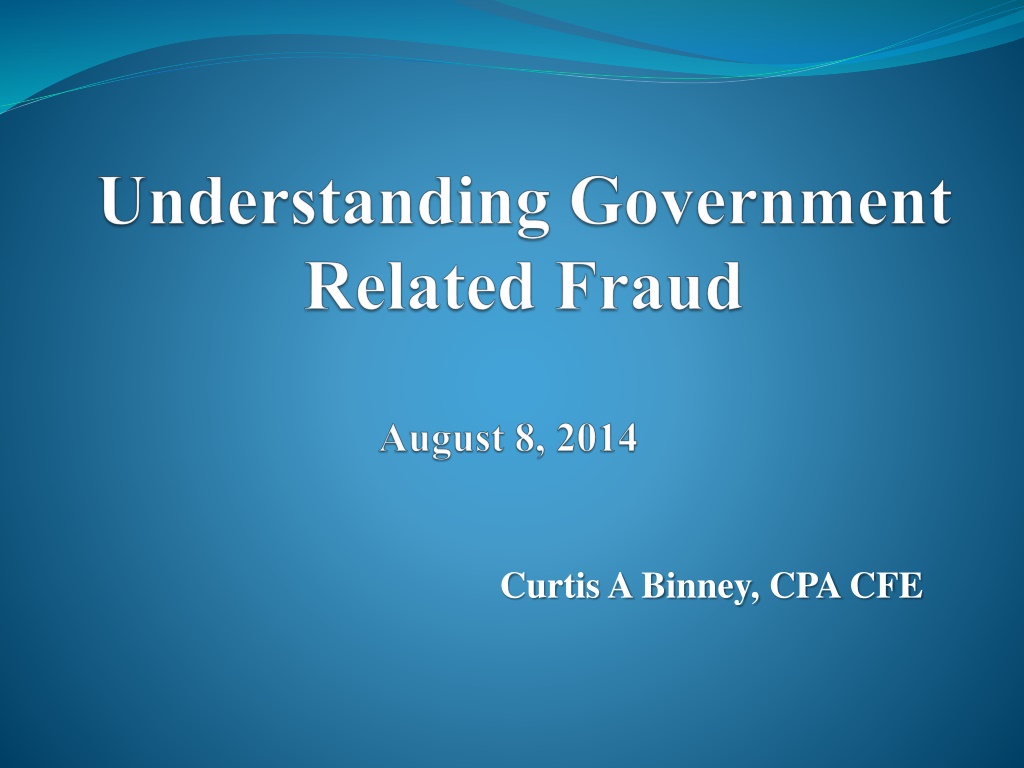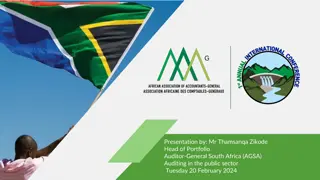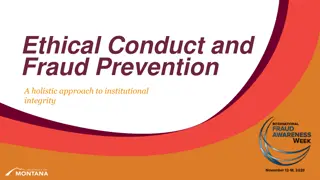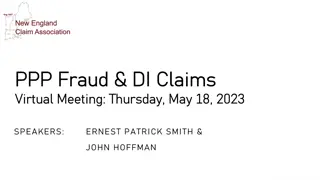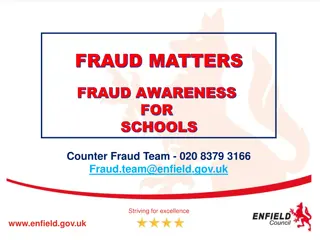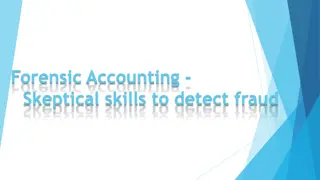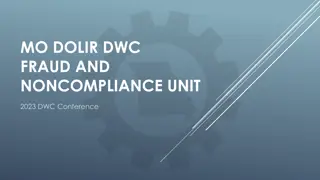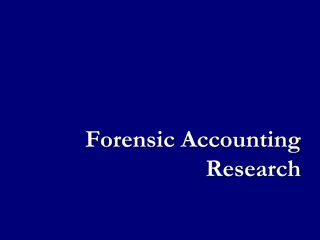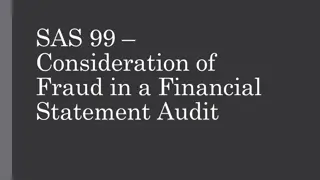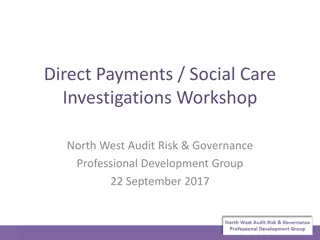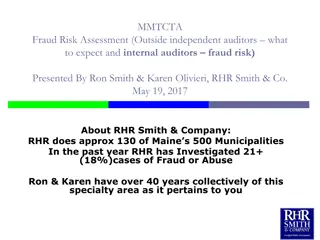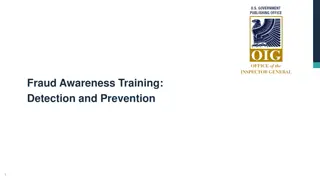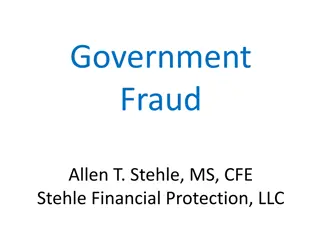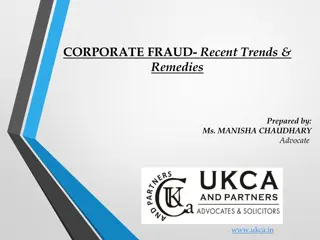Understanding Fraud in Auditing and Government
Fraud encompasses multifarious means of deception for personal gain and can significantly impact financial statements. Government fraud involves intentional acts to deceive, resulting in substantial losses annually. Auditors must diligently identify and address fraud risks to ensure the accuracy and reliability of financial reporting.
Download Presentation

Please find below an Image/Link to download the presentation.
The content on the website is provided AS IS for your information and personal use only. It may not be sold, licensed, or shared on other websites without obtaining consent from the author. Download presentation by click this link. If you encounter any issues during the download, it is possible that the publisher has removed the file from their server.
E N D
Presentation Transcript
What is Fraud ? all multifarious means which human ingenuity can devise, and which are sorted to by one individual to get an advantage over another by false suggestions or suppression of the truth. Blacks Law Dictionary
Government Fraud Government Fraud intentional acts designed to deprive the government of funds by deception or other unfair means. In 2008, losses from fraud, misuse, and other types of improper government payments are about $100 billion a year.
SAS 99 Establishes standards and provides guidance to auditors in fulfilling their responsibility, as it relates to fraud, in an audit of financial statements, conducted in accordance with GAAS
The Auditors Responsibility the auditor has a responsibility to plan and perform the audit to obtain reasonable assurance about whether the financial statements are free of material misstatement, whether caused by error or fraud. even a properly planned and performed audit may not detect a material misstatement resulting from fraud. Provide reasonable assurance not absolute assurance
Inherent Conflicts in Auditing Auditor is often paid directly by the audit client. Desire to keep a happy client versus the need to persistent Human nature to trust versus need for professional skepticism Natural assumption that misstatements are due to errors instead of fraud Pressures for profitability, productivity, timeliness versus the need for more evidence and documentation
Auditors Perspective Errors are easier to identify (no intent to conceal) Fraud is harder to identify (intent to conceal) Therefore, auditing for misstatements caused by fraud dictates the need for a different audit response than the risk of misstatements caused by errors
Characteristics of SAS 99 Fraud Intentional acts that result in a material misstatement of the financial statements Auditors do not make a legal determination of whether a fraud has occurred Intent is often very difficult to determine Auditors make a determination as to whether evidence indicates a fraud may exist
Government Characteristics Affecting Motive/Pressures Profit motive generally less applicable Political promises and favors may impact decisions and actions Limited competitive environment Budgetary and other legal compliance pressures Limited use of external financial statements Limited financial related incentives for management Generally less pay than comparable private sector position
The Fraud Triangle Motive Opportunity Rationalization
Fraud Risk Factors Motive/Incentive/Pressure (the reason to commit fraud) Opportunity (the ability to commit fraud) Rationalization (the justification to commit fraud)
Types of SAS 99 Fraud Misstatements arising from fraudulent financial reporting Intentional misrepresentation in or omission of material events, transactions or other information Intentional misapplication of GAAP Falsification or manipulation of accounting records or documents Misstatements arising from misappropriation of assets Theft that causes the financial statements to not be fairly presented in all material respects
Audit Fraud Process Brainstorming Obtaining Risk Info Documenting On-Going Process Throughout The Audit Communicating Identifying Risks Evaluating Evidence Assessing Risks Responding to Risks
Brainstorming Initially during audit planning Interactive exchange of ideas Insights of more experienced team members How and where the financial statements might be susceptible to fraud Emphasize importance of proper state of mind (professional skepticism) during the audit Include risk of management override of controls Communication of fraud risks among team members should continue throughout the audit
Obtaining Risk Information Inquiries of management and others about fraud risk and their response to the risk Consider unusual relationships that analytical procedures identify Consider the presence of fraud risk factors Consider results of procedures over acceptance and continuance of clients Consider any reviews of interim financials Consider inherent risks at account balance/ transaction class level
Obtaining Risk Information (Cont) Evaluate the relationship between management and the audit committee or equivalent (New) Talk to the internal auditors (New) Inquire directly of the audit committee or equivalent (New) Entity employees may just waiting to be asked Be alert for inconsistent responses to inquiries and use professional judgment in deciding when corroboration is needed
Identifying Fraud Risks Professional judgment required Risk attributes to consider: (New) Type of risk Significance of the risk Likelihood of the risk Pervasiveness of the risk Consider these in the context of the fraud triangle; but do not assume that if all three are not evident, there is no risk
Identifying Fraud Risks (cont) Consider the entity s size, complexity, and ownership/governing attributes Consider assertions, accounts, and transaction classes that have high inherent risk due to a high degree of management judgment and subjectivity Consider whether identified risks pertain to (A) individual account balances, transaction classes, or assertions or (B) the financial statements as a whole Should ordinarily presume there is a risk of material misstatement due to revenue recognition fraud Always consider management s ability to override controls apart from specifically identified risks
Assessing Fraud Risks Assessment should take into account an evaluation of the entity s programs and controls that address fraud risks There may be specific programs/controls that address specific fraud risks Are they properly designed and been implemented? There may be broader programs designed to prevent, deter, or detect fraud risk For example: programs that promote a culture of honesty and ethical behavior
Responding to Fraud Risks There are three ways to respond: General considerations related to the overall way the audit is conducted Change the nature, timing, or extent of audit procedures Performance of procedures to address the risks related to management s ability to override controls
General Considerations Heightened professional skepticism and assessment of audit evidence Design different procedures Corroborate management explanations Assignment of personnel and supervision Additional or more experienced staff Use of specialists Greater supervision Reassess accounting principles application Add unpredictability to audit procedures
Nature, Timing and Extent of Audit Procedures Use more reliable or corroborative procedures More inspection or observation Expanded inquiries or independent confirmation Alter the timing of substantive tests Conduct more testing Larger sample sizes Analytical procedures at a more detailed level Use CAATs to test all transactions of a population
Responses to Management Override Examine journal entries and other adjustments for evidence of material misstatement Review accounting estimates for evidence of biases that could result in material misstatements due to fraud Evaluate the business rationale for significant unusual transactions
Responses to Management Override Appropriate for every audit absent a conclusion by the auditor that they are unnecessary document such a conclusion For audits of public entities, these should be performed For audits of nonpublic entities, these should generally be performed Bottom line: if you decide not to perform these procedures, you better have good, well-documented reasons
Evaluating Audit Evidence for Fraud Assess and reassess risks of material misstatement due to fraud throughout the audit Audit test results may alter previous assessments of risk Audit test results may, in and of themselves, be indicative of fraud Be alert for: (New) Discrepancies in the accounting records Conflicting or missing evidential matter Problematic or unusual relationships between the auditor and client
Responding to Misstatements That May Be Result of Fraud Consider the implications for other parts of the audit Discuss the matter and the approach for further investigation with an appropriate level of management; and with senior management: and the audit committee Attempt to obtain additional evidential matter to determine whether material fraud has occurred Consider the need for and timing of discussions with the audit committee or board of directors (New) If appropriate, suggest that the client consult with legal counsel When appropriate, consider withdrawing from the engagement (consult with auditor s legal counsel)
Communicating Fraud Evidence Whenever evidence of fraud is found, it should be brought to the attention of the appropriate level of management Even if the matter is inconsequential Report directly to the audit committee when: Fraud causes a material misstatement Fraud involves senior management Reach an advance understanding with the audit committee about fraud involving lower-level employees
Communicating Fraud Evidence Communicating to parties other than management or audit committee may be required To comply with legal or regulatory requirements In response to successor auditor inquiries (per SAS 84) In response to a subpoena To meet Yellow Book standards Consult your attorney
Types of Government Fraud Public Corruption False Claims and Statements Procurement Fraud Social Security Fraud Welfare Fraud Medicare and Medicaid Fraud Tax Fraud Counterfeit Currency Conspiracy to Defraud the Government Grant Fraud Asset Misappropriations
Public Corruption Corruption the wrongful use of influence in a business dealing to procure a benefit for the actor or another person, contrary to their duty to their employer. Bribery Kickbacks Illegal gratuities Economic extortion Collusion Conflicts of Interest
Corruption Schemes Bribery and Kickbacks Bribery the offering, giving, receiving, or soliciting of anything of value to influence an official act. Kickbacks undisclosed payments by vendors to employees of purchasing organizations, to influence an official act. Both nearly always include collusion
Corruption Schemes (cont) Illegal Gratuities something of value given to another party to reward a party that has already been made. Economic Extortion employee or official through the wrongful use of actual or threatened force or fear, demands money or some other consideration to make a particular decision.
ACFE Corruption Warning Signs Regularly accepts inappropriate gifts Very friendly social relationships Extravagant lifestyle Override of existing rules and SOPs Official makes excuses for deficiencies in payers performance Extreme personal pressures Suspected fraudster involved with organization Decrease in quality and/or increase in price
False Claims and Statements False Statement a statement that was known to be untrue when it was made. Section 1001, Title 18 USC. Elements of a false statement: Defendant made a false statement Statement was material Statement was within the jurisdiction of a federal agency. Defendant knew the claim was false The Agency did not have to rely on the statement
Types of False Statements Contracting bids or proposals False certifications or assurances contract Billing documents Records or invoices Progress reports Test or inspection results Duplicate or altered invoices Inflated costs or substitution of cheaper goods Fictitious transactions
Procurement Fraud Public Procurement refers to those processes, procedures, and entities involved in the government s process of acquiring goods and services. Collusion among contractors Collusion between contractors and employees Performance Schemes
Methods of Procurement Simplified acquisition Sealed Bids Competetive negotiation Noncompetetive proposals (sole source)
Phases in Procurement Pre-solicitation Phase Solicitation Phase Bid-evaluation Phase Post Award Phase Administration Phase
Collusion Among Contractors Collusion is a type of fraud where two or more individuals agree to commit an act designed to deceive or gain an unfair advantage. Common Types Complementary bidding (token bids) Bid rotation Bid suppression Market division
Complementary Bidding Complementary bidding (also known as protective, shadow, or cover bidding) occurs when competitors submit token bids that are not serious attempts to win. For the conspirators to bid higher than the designated winning bidder, they might agree to submit: Bids that are too high to be accepted Bids that appear to be competitive in price but deliberately fail to meet other requirements of the tender Bids that contain special terms that will not be acceptable to the buyer
Bid Rotation Bid rotation schemes occur when two or more contractors conspire to alternate the business between them on a rotating basis. Instead of engaging in competitive contracting, which drives down the contract price, contractors perpetrating these schemes prefer exchanging information on contract solicitations to guarantee that each contractor will win a share of the purchasing entity s business. Similar to complementary bidding schemes, bid rotation schemes may be coupled with a scheme to award subcontracts to losing bidders. This allows losing bidders to improve their cash flow as they wait for their turn to win. Similarly, losing bidders might receive a percentage of the winning company s profits.
Bid Suppression Bid suppression occurs when two or more contractors enter an illegal agreement whereby at least one of the conspirators refrains from bidding or withdraws a previously submitted bid. The goal of these schemes is to ensure that a particular competitor s bid will be accepted.
Market Division Market division schemes involve agreements in which competitors divide markets among themselves and refrain from competing in each other s designated portion of the market. Markets are generally divided according to geographic area the competitors take turns on contracts according to the geographic area or are based on the customer the competitors allocate specific customers or types of customers among themselves.
Market Division The result of these schemes is that competing firms will not bid against each other, or they will submit only complementary bids when a solicitation for bids is made by a customer or in an area not assigned to them. The customer thereby loses the benefit of true competition and ends up paying a higher price than would be dictated by fair bidding under normal economic forces. Corrupt contractors often conceal market division schemes by submitting bids from shell companies (i.e., companies that have no physical presence and generate little independent economic value).
Collusion Between Contractors and Employees Types of Schemes Need recognition Bid tailoring Bid manipulation Unbalanced bidding Leaking bid data Bid splitting Unjustified sole source awards
Needs Recognition Generally, procurement actions begin with the procuring entity making a determination of its general needs. These initial determinations include assessments of the types and amounts of goods or services required to meet the entity s needs. Fraud occurring during this phase of the procurement process may result in decisions to purchase excessive or possibly unnecessary goods or services. Generally, procurement actions begin with the procuring entity making a determination of its general needs. These initial determinations include assessments of the types and amounts of goods or services required to meet the entity s needs. Fraud occurring during this phase of the procurement process may result in decisions to purchase excessive or possibly unnecessary goods or services.
Needs Recognition Typically, need recognition schemes involve the following scenarios: Purchases for personal use or resale In these schemes, employees with procurement authority exploit their position of power by using their employer s funds to obtain items for their personal use or resale (e.g., tools, office supplies, computers, automobile parts, etc.). Unnecessary purchases In these schemes, an employee of the buyer receives something of value and in return recognizes a need for a particular product or service offered by the supplier. Excessive purchases In these schemes, a corrupt employee purchases goods or services in excess of amounts actually needed.
Bid Tailoring Bid-tailoring schemes occur during the pre-solicitation phase. In these schemes, an employee with procurement responsibilities, often in collusion with a supplier or contractor, manipulates bid specifications to give an unfair advantage to a certain contractor. Bid specifications are a list of elements, measurements, materials, characteristics, required functions, product name or brand number, and other specific information relevant for completion of the project. Specifications are included to assist contractors in the bidding process, informing them what they are required to do and providing information necessary to make and accept bids.
Bid Manipulation In these schemes, which occur during the solicitation phase, a procuring employee manipulates the bidding process to benefit a favored contractor or supplier. Some common ways to commit these schemes include: Accepting late bids Altering bids Extending bid opening dates Prematurely opening bids Unnecessarily re-bidding work Discarding or losing a bid or proposal Improper disqualification
Unbalanced Bidding Unbalanced bidding is a type of bid submission scheme in which a bidder, usually in collusion with contracting personnel, becomes aware that one of several line items in a request for a bid on certain works, goods, or services will not be called for under the contract. This information, which is not available to other bidders, allows the favored firm to submit a very low price for the line item and to be the overall low bidder.
